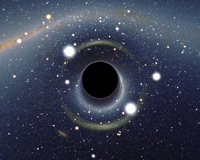Difference between revisions of "Black Hole"
m (Text replacement - "http://" to "https://") |
|||
| Line 1: | Line 1: | ||
[[File:lighterstill.jpg]][[File:Blackhole.jpg|right|frame]] | [[File:lighterstill.jpg]][[File:Blackhole.jpg|right|frame]] | ||
| − | According to the general theory of [[relativity]], a '''black hole''' is a region of [[space]] from which nothing, including [[light]], can escape. It is the result of the deformation of [[spacetime]] caused by a very compact [[mass]]. Around a black hole there is an undetectable [[surface]] which marks the point of no return, called an [ | + | According to the general theory of [[relativity]], a '''black hole''' is a region of [[space]] from which nothing, including [[light]], can escape. It is the result of the deformation of [[spacetime]] caused by a very compact [[mass]]. Around a black hole there is an undetectable [[surface]] which marks the point of no return, called an [https://en.wikipedia.org/wiki/Event_horizon event horizon]. It is called "black" because it absorbs all the [[light]] that hits it, [[reflecting]] nothing, just like a perfect black [[body]] in [https://en.wikipedia.org/wiki/Thermodynamics thermodynamics]. Under the [[theory]] of [[quantum mechanics]] black holes [[possess]] a [[temperature]] and emit [https://en.wikipedia.org/wiki/Hawking_radiation Hawking radiation]. |
| − | Despite its [[invisible]] interior, a black hole can be [[observed]] through its [[interaction]] with other [[matter]]. A black hole can be [[inferred]] by tracking the [[Motion|movement]] of a [[group]] of [[stars]] that [[orbit]] a region in [[space]]. Alternatively, when [[gas]] falls into a [ | + | Despite its [[invisible]] interior, a black hole can be [[observed]] through its [[interaction]] with other [[matter]]. A black hole can be [[inferred]] by tracking the [[Motion|movement]] of a [[group]] of [[stars]] that [[orbit]] a region in [[space]]. Alternatively, when [[gas]] falls into a [https://en.wikipedia.org/wiki/Stellar_black_hole stellar black hole] from a [https://en.wikipedia.org/wiki/Binary_star companion star], the [[gas]] [[spiral]]s inward, heating to very high [[temperatures]] and emitting large amounts of [[radiation]] that can be detected from earthbound and [[Earth]]-orbiting [https://en.wikipedia.org/wiki/Telescope telescopes]. |
| − | [[Astronomers]] have identified numerous stellar black hole [[candidates]], and have also found [[evidence]] of [ | + | [[Astronomers]] have identified numerous stellar black hole [[candidates]], and have also found [[evidence]] of [https://en.wikipedia.org/wiki/Supermassive_black_hole supermassive black holes] at the [[center]] of [[galaxies]]. After [[observing]] the [[motion]] of nearby stars for 16 years, in 2008 astronomers found compelling [[evidence]] that a [https://en.wikipedia.org/wiki/Supermassive_black_hole supermassive black hole] of more than 4 million solar masses is located near the [https://en.wikipedia.org/wiki/Sagittarius_A* Sagittarius A*] region in the center of the [[Milky Way]] [[galaxy]].[https://en.wikipedia.org/wiki/Black_hole] |
[[Category: Astronomy]] | [[Category: Astronomy]] | ||
Latest revision as of 23:42, 12 December 2020
According to the general theory of relativity, a black hole is a region of space from which nothing, including light, can escape. It is the result of the deformation of spacetime caused by a very compact mass. Around a black hole there is an undetectable surface which marks the point of no return, called an event horizon. It is called "black" because it absorbs all the light that hits it, reflecting nothing, just like a perfect black body in thermodynamics. Under the theory of quantum mechanics black holes possess a temperature and emit Hawking radiation.
Despite its invisible interior, a black hole can be observed through its interaction with other matter. A black hole can be inferred by tracking the movement of a group of stars that orbit a region in space. Alternatively, when gas falls into a stellar black hole from a companion star, the gas spirals inward, heating to very high temperatures and emitting large amounts of radiation that can be detected from earthbound and Earth-orbiting telescopes.
Astronomers have identified numerous stellar black hole candidates, and have also found evidence of supermassive black holes at the center of galaxies. After observing the motion of nearby stars for 16 years, in 2008 astronomers found compelling evidence that a supermassive black hole of more than 4 million solar masses is located near the Sagittarius A* region in the center of the Milky Way galaxy.[1]
